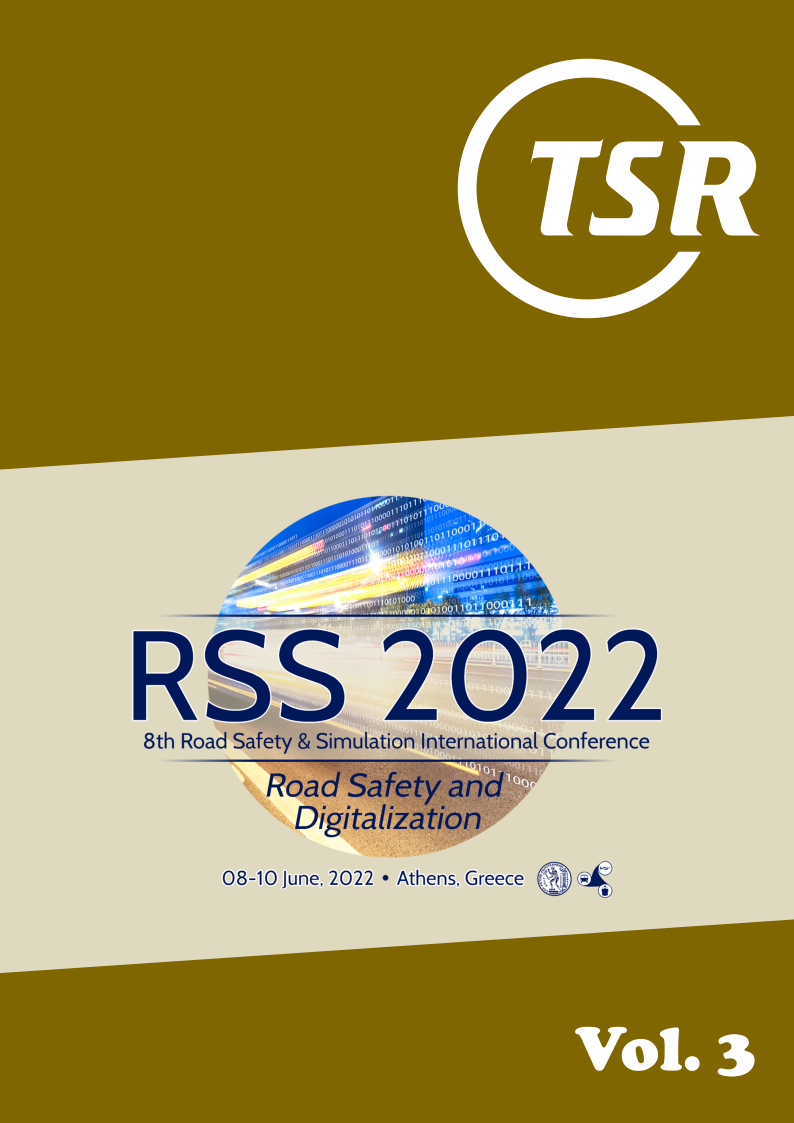Driver performance at horizontal curves: bridging critical research gaps to increase safety
DOI:
https://doi.org/10.55329/lmji8901Keywords:
horizontal curve, crash rate, countermeasure development, traffic volumeAbstract
Horizontal curve segments are locations of critical safety concern given their high crash rates. Extensive research has identified that behavioral factors influence the occurrence of such crashes. However, the most beneficial countermeasure for a curve is not always implemented or is implemented inefficiently due to a lack of full understanding of driver behavior at curves compared to tangent roadway segments. The aim of this research is to identify the conditions that impact safety at curve locations compared to tangent segment locations. This is completed through a literature review of current research relating to curve safety issues and a safety analysis of curve and tangent segment data using a novel dataset that includes curve data throughout a region. The results of this study revealed several factors that cause horizontal curves to have a higher crash rate related to driver performance, including the increased task load and demand required at curve segments compared to tangent segments, and that horizontal curve segments have an increased rate of crashes per mile with an increasing AADT compared to tangent segments. Further, horizontal curve segments along one-way operations are of increased safety concern for drivers compared to tangent segments and two-way operations. The results of this study present the conditions that can be more carefully considered in future studies and analyses to consider the human factor cause behind the increased safety issue at curve segments.
Downloads
References
Ai, C., Y. Tsai (2015), ‘Automatic Horizontal Curve Identification and Measurement Method Using GPS Data’, Journal of Transportation Engineering, 141 (2), https://doi.org/10.1061/(asce)te.1943-5436.0000740.
Bella, F. (2014), ‘Driver perception hypothesis: Driving simulator study’, Transportation Research Part F: Traffic Psychology and Behaviour, 24, 183–196, https://doi.org/10.1016/j.trf.2014.04.007.
Calvi, A. (2014), ‘A Study on Driving Performance Along Horizontal Curves of Rural Roads’, Journal of Transportation Safety & Security, 7 (3), 243–267, https://doi.org/10.1080/19439962.2014.952468.
Charlton, S. G. (2007), ‘The role of attention in horizontal curves: A comparison of advance warning, delineation, and road marking treatments’, Accident Analysis & Prevention, 39 (5), 873–885, https://doi.org/10.1016/j.aap.2006.12.007.
Cheung, J. (2014), ‘Horizontal Curve Safety’ (Washington, D.C., USA: Federal Highway Administration ), https://safety.fhwa.dot.gov/roadway_dept/countermeasures/horicurves/cmhoricurves/horiz_curve.pdf, accessed 6 October 2022.
Coutton-Jean, C., D. R. Mestre, C. Goulon, R. J. Bootsma (2009), ‘The role of edge lines in curve driving’, Transportation Research Part F: Traffic Psychology and Behaviour, 12 (6), 483–493, https://doi.org/10.1016/j.trf.2009.04.006.
de Craen, S., D. A. M. Twisk, M. P. Hagenzieker, et al. (2007), ‘Overestimation of Skills Affects Drivers’ Adaptation to Task Demands’, Driving Assessment Conference, 4, 39–45, https://doi.org/10.17077/drivingassessment.1212.
de Craen, S., D. A. M. Twisk, M. P. Hagenzieker, et al. (2011), ‘Do young novice drivers overestimate their driving skills more than experienced drivers? Different methods lead to different conclusions’, Accident Analysis & Prevention, 43 (5), 1660–1665, https://doi.org/10.1016/j.aap.2011.03.024.
Denton, G. G. (1966), ‘A Subjective Scale of Speed when Driving a Motor Vehicle’, Ergonomics, 9 (3), 203–210, https://doi.org/10.1080/00140136608964371.
Denton, G. G. (1967), ‘The effect of speed and speed change on drivers’ speed judgement’ (UK: Road Research Lab), Rrl report 97.
Elvik, R. (2019), ‘The more (sharp) curves, the lower the risk’, Accident Analysis & Prevention, 133, 105322, https://doi.org/10.1016/j.aap.2019.105322.
Evans, L. (1970), ‘Speed Estimation from a Moving Automobile’, Ergonomics, 13 (2), 219–230, https://doi.org/10.1080/00140137008931135.
Figueroa Medina, A. M., A. P. Tarko (2007), ‘Speed Changes in the Vicinity of Horizontal Curves on Two-Lane Rural Roads’, Journal of Transportation Engineering, 133 (4), 215–222, https://doi.org/10.1061/(asce)0733-947x(2007)133:4(215).
Fildes, B. N., T. J. Triggs (1985), ‘The on effect of changes in curve geometry magnitude estimates of road-like perspective curvature’, Perception & Psychophysics, 37 (3), 218–224, https://doi.org/10.3758/bf03207567.
Fink, K. L., R. A. Krammes (1995), ‘Tangent length and sight distance effects on accident rates at horizontal curves on rural two-lane highways’, Transportation Research Record: Journal of the Transportation Research Board, 1500, 162–168, https://onlinepubs.trb.org/Onlinepubs/trr/1995/1500/1500-020.pdf, accessed 5 October 2022.
Finn, P., B. W. E. Bragg (1986), ‘Perception of the risk of an accident by young and older drivers’, Accident Analysis & Prevention, 18 (4), 289–298, https://doi.org/10.1016/0001-4575(86)90043-6.
Fitzsimmons, E. J., S. S. Nambisan, R. R. Souleyrette, V. Kvam (2013), ‘Analyses of Vehicle Trajectories and Speed Profiles Along Horizontal Curves’, Journal of Transportation Safety & Security, 5 (3), 187–207, https://doi.org/10.1080/19439962.2012.680573.
Fuller, R. (2005), ‘Towards a general theory of driver behaviour’, Accident Analysis & Prevention, 37 (3), 461–472, https://doi.org/10.1016/j.aap.2004.11.003.
Gibreel, G. M., S. M. Easa, Y. Hassan, I. A. El-Dimeery (1999), ‘State of the Art of Highway Geometric Design Consistency’, Journal of Transportation Engineering, 125 (4), 305–313, https://doi.org/10.1061/(asce)0733-947x(1999)125:4(305).
Glennon, J. C., T. R. Neuman, J. E. Leisch (1983), ‘Safety and Operational Considerations for Design of Rural Highways Curve’ (Washington, D.C., USA: Transportation Research Board), https://mchenrysoftware.com/Leisch%20Curve%20Study.pdf, accessed 5 October 2022.
Gooch, J. P., V. V. Gayah, E. T. Donnell (2018), ‘Safety performance functions for horizontal curves and tangents on two lane, two way rural roads’, Accident Analysis & Prevention, 120, 28–37, https://doi.org/10.1016/j.aap.2018.07.030.
Hummer, J. E., W. Rasdorf, D. J. Findley, et al. (2010), ‘Curve Collisions: Road and Collision Characteristics and Countermeasures’, Journal of Transportation Safety & Security, 2 (3), 203–220, https://doi.org/10.1080/19439961003734880.
Høye, A. K., I. S. Hesjevoll (2020), ‘Traffic volume and crashes and how crash and road characteristics affect their relationship – A meta-analysis’, Accident Analysis & Prevention, 145, 105668, https://doi.org/10.1016/j.aap.2020.105668.
Jiang, C., G. Underwood, C. I. Howarth (1992), ‘Towards a theoretical model for behavioural adaptations to changes in the road transport system’, Transport Reviews, 12 (3), 253–264, https://doi.org/10.1080/01441649208716819.
Khan, G., A. R. Bill, M. V. Chitturi, D. A. Noyce (2013), ‘Safety Evaluation of Horizontal Curves on Rural Undivided Roads’, Transportation Research Record: Journal of the Transportation Research Board, 2386 (1), 147–157, https://doi.org/10.3141/2386-17.
Labi, S. (2011), ‘Efficacies of roadway safety improvements across functional subclasses of rural two-lane highways’, Journal of Safety Research, 42 (4), 231–239, https://doi.org/10.1016/j.jsr.2011.01.008.
Lamm, R., E. M. Choueiri, J. C. Hayward, A. Paluri (1988), ‘Possible design procedure to promote design consistency in highway geometric design on two-lane rural roads’, Transportation Research Record: Journal of the Transportation Research Board, 1195, 111–122, https://onlinepubs.trb.org/Onlinepubs/trr/1988/1195/1195-011.pdf, accessed 5 October 2022.
massDOT (2019), ‘Road Inventory 2018’ (Massachusetts Department of Transportation), https://geo-massdot.opendata.arcgis.com/datasets/46bb709a682a4373b57dfa832f35ade6/about accessed 6 October 2022.
massDOT (n/d), ‘Crash Data Portal’ (Massachusetts Department of Transportation), https://apps.impact.dot.state.ma.us, accessed 22 September 2022.
Matthews, M. L., A. R. Moran (1986), ‘Age differences in male drivers' perception of accident risk: The role of perceived driving ability’, Accident Analysis & Prevention, 18 (4), 299–313, https://doi.org/10.1016/0001-4575(86)90044-8.
McDonald, L. B., N. C. Ellis (1975), ‘Driver workload for various turn radii and speeds’, Transportation Research Record: Journal of the Transportation Research Board, 530, 18–30, https://onlinepubs.trb.org/Onlinepubs/trr/1988/1195/1195-011.pdf, accessed 5 October 2022.
Milos̆ević, S., J. Milić (1990), ‘Speed perception in road curves’, Journal of Safety Research, 21 (1), 19–23, https://doi.org/10.1016/0022-4375(90)90044-c.
Montella, A., F. Galante, F. Mauriello, M. Aria (2015), ‘Continuous Speed Profiles to Investigate Drivers' Behavior on Two-Lane Rural Highways’, Transportation Research Record: Journal of the Transportation Research Board, 2521 (1), 3–11, https://doi.org/10.3141/2521-01.
Moreno, A. T., A. Garcia, F. J. Camacho‐Torregrosa, C. Llorca (2013), ‘Influence of highway three‐dimensional coordination on drivers’ perception of horizontal curvature and available sight distance’, IET Intelligent Transport Systems, 7 (2), 244–250, https://doi.org/10.1049/iet-its.2012.0146.
NHTSA (2020), ‘Early Estimate of Motor Vehicle Traffic Fatalities in 2019’ (Washington DC, USA: National Highway Traffic Safety Administration, National Center for Statistics and Analysis), https://crashstats.nhtsa.dot.gov/Api/Public/Publication/812946, accessed 6 October 2022.
Pulugurtha, S. S., V. R. Sambhara (2011), ‘Pedestrian crash estimation models for signalized intersections’, Accident Analysis & Prevention, 43 (1), 439–446, https://doi.org/10.1016/j.aap.2010.09.014.
Retting, R. A., C. M. Farmer (1998), ‘Use of Pavement Markings to Reduce Excessive Traffic Speeds on Hazardous Curves’, Transportation Research Record: Journal of the Transportation Research Board, 68 (9), 30–36, https://onlinepubs.trb.org/Onlinepubs/trr/1988/1195/1195-011.pdf, accessed 5 October 2022.
Reymond, G., A. Kemeny, J. Droulez, A. Berthoz (2001), ‘Role of Lateral Acceleration in Curve Driving: Driver Model and Experiments on a Real Vehicle and a Driving Simulator’, Human Factors: The Journal of the Human Factors and Ergonomics Society, 43 (3), 483–495, https://doi.org/10.1518/001872001775898188.
Ryan, A., C. Ai, C. Fitzpatrick, M. Knodler (2022), ‘Crash proximity and equivalent property damage calculation techniques: An investigation using a novel horizontal curve dataset’, Accident Analysis & Prevention, 166, 106550, https://doi.org/10.1016/j.aap.2021.106550.
Taylor, D. H. (1964), ‘Drivers’ Galvanic Skin Response And The Risk Of Accident’, Ergonomics, 7 (4), 439–451, https://doi.org/10.1080/00140136408930761.
Taylor, J. I., H. W. McGee, E. L. H. Seguin, Roberts (1972), ‘Roadway Delineation Systems, National Cooperative Highway Research Program Report 130’ (Washington, D.C., USA: Highway Research Board ), https://onlinepubs.trb.org/Onlinepubs/nchrp/nchrp_rpt_130.pdf, accessed 6 October 2022.
Torbic, D. J., D. Harwood, D. K. Gilmore, et al. (2004), ‘Guidance for implementation of the AASHTO strategic highway safety plan. Volume 7: A guide for reducing collisions on horizontal curves’ (Washington, D.C., USA: Transportation Research Board), http://onlinepubs.trb.org/onlinepubs/nchrp/nchrp_rpt_500v7.pdf, accessed 5 October 2022.
Triggs, T. J., J. S. Berenyi (1982), ‘Estimation of Automobile Speed under Day and Night Conditions’, Human Factors: The Journal of the Human Factors and Ergonomics Society, 24 (1), 111–114, https://doi.org/10.1177/001872088202400111.
Wilde, G. J. S. (1982), ‘The Theory of Risk Homeostasis: Implications for Safety and Health’, Risk Analysis, 2 (4), 209–225, https://doi.org/10.1111/j.1539-6924.1982.tb01384.x.
Wood, J. S., E. T. Donnell (2014), ‘Stopping Sight Distance and Horizontal Sight Line Offsets at Horizontal Curves’, Transportation Research Record: Journal of the Transportation Research Board, 2436 (1), 43–50, https://doi.org/10.3141/2436-05.
Downloads
Published
How to Cite
Issue
Section
Categories
License
Copyright (c) 2022 Alyssa Ryan, Emily Hennessy, Chengbo Ai, Wooseong Kwon, Cole Fitzpatrick, Michael A. Knodler Jr.

This work is licensed under a Creative Commons Attribution 4.0 International License.













